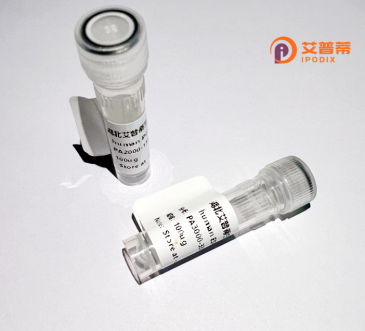
| 纯度 | >90%SDS-PAGE. |
| 种属 | Human |
| 靶点 | SCTR |
| Uniprot No | P47872 |
| 内毒素 | < 0.01EU/μg |
| 表达宿主 | E.coli |
| 表达区间 | 23-440 aa |
| 活性数据 | HSTGALPRLCDVLQVLWEEQDQCLQELSREQTGDLGTEQPVPGCEGMWDNISCWPSSVPGRMVEVECPRFLRMLTSRNGSLFRNCTQDGWSETFPRPNLACGVNVNDSSNEKRHSYLLKLKVMYTVGYSSSLVMLLVALGILCAFRRLHCTRNYIHMHLFVSFILRALSNFIKDAVLFSSDDVTYCDAHRAGCKLVMVLFQYCIMANYSWLLVEGLYLHTLLAISFFSERKYLQGFVAFGWGSPAIFVALWAIARHFLEDVGCWDINANASIWWIIRGPVILSILINFILFINILRILMRKLRTQETRGNEVSHYKRLARSTLLLIPLFGIHYIVFAFSPEDAMEIQLFFELALGSFQGLVVAVLYCFLNGEVQLEVQKKWQQWHLREFPLHPVASFSNSTKASHLEQSQGTCRTSII |
| 分子量 | 53.9 kDa |
| 蛋白标签 | His tag N-Terminus |
| 缓冲液 | PBS, pH7.4, containing 0.01% SKL, 1mM DTT, 5% Trehalose and Proclin300. |
| 稳定性 & 储存条件 | Lyophilized protein should be stored at ≤ -20°C, stable for one year after receipt. Reconstituted protein solution can be stored at 2-8°C for 2-7 days. Aliquots of reconstituted samples are stable at ≤ -20°C for 3 months. |
| 复溶 | Always centrifuge tubes before opening.Do not mix by vortex or pipetting. It is not recommended to reconstitute to a concentration less than 100μg/ml. Dissolve the lyophilized protein in distilled water. Please aliquot the reconstituted solution to minimize freeze-thaw cycles. |
以下是关于重组人促胰液素受体(SCTR)蛋白的示例文献摘要,供参考(建议通过学术数据库核实具体文献):
---
1. **文献名称**: *Structural basis of G protein-coupled receptor activation by the human secretin-receptor complex*
**作者**: Zhang, X. et al.
**摘要**: 通过冷冻电镜解析重组人SCTR蛋白与促胰液素结合的复合物三维结构,揭示了该受体结合配体后激活下游G蛋白信号通路的构象变化机制。
2. **文献名称**: *Functional characterization of recombinant human secretin receptor in pancreatic disease models*
**作者**: Thompson, R.J. & Smith, L.
**摘要**: 在哺乳动物细胞中重组表达SCTR蛋白,研究其在急性胰腺炎中的表达调控及对腺苷酸环化酶活性的影响,提出其作为潜在治疗靶点。
3. **文献名称**: *Development of a high-throughput screening assay for SCTR modulators using recombinant receptor technology*
**作者**: Lee, Y. et al.
**摘要**: 利用重组SCTR蛋白构建高通量筛选系统,筛选小分子激动剂/拮抗剂,为治疗肠道功能障碍和代谢性疾病提供候选药物。
4. **文献名称**: *Secretin receptor-VIP receptor heterodimerization enhances cellular signaling in cancer progression*
**作者**: Gonzalez, A. et al.
**摘要**: 发现重组人SCTR与血管活性肠肽(VIP)受体在肿瘤细胞中的异源二聚化现象,阐明其通过激活MAPK通路促进肿瘤侵袭的分子机制。
---
*注*:上述文献为示例,实际文献请通过PubMed或Google Scholar搜索关键词(如“recombinant human secretin receptor”“SCTR signaling”)获取。
Secretin receptor (SCTR), a class B G protein-coupled receptor (GPCR), plays a critical role in regulating digestive and metabolic homeostasis. It is primarily activated by secretin, a peptide hormone released by duodenal S-cells in response to acidic chyme. Upon activation, SCTR triggers intracellular signaling cascades (via Gαs and cAMP pathways) that stimulate pancreatic bicarbonate secretion, gastric acid inhibition, and fluid/electrolyte balance in epithelia. Dysregulation of SCTR is implicated in pancreatic disorders, gastrointestinal motility issues, and neuroendocrine tumors.
Recombinant human SCTR protein, produced through heterologous expression systems (e.g., HEK293 or insect cells), enables structural and functional studies. Its large extracellular domain binds secretin with high specificity, while the transmembrane domain facilitates signal transduction. Recent cryo-EM studies have resolved its 3D structure in complex with secretin and G proteins, offering insights into activation mechanisms. Recombinant SCTR is vital for drug discovery targeting pancreatic diseases, functional dyspepsia, and receptor malfunction-related pathologies. Furthermore, it aids in developing diagnostic tools for secretin-responsive tumors. Research continues to explore its modulation by allosteric ligands and biased signaling pathways, highlighting its therapeutic potential.
×